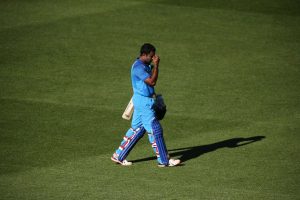FEBRUARY 3, 2019
Brief Scorecard: India 252 (Rayudu 90, Pandya 45, Shankar 45, Henry 4-35, Boult 3-39) beat New Zealand 217 (Neesham 44, Chahal 3-41) by 35 runs

Wellington, NEW ZEALAND – Wanting to test their batting by deciding to bat on a moist Wellington surface, what India found out was not be all pretty but immensely satisfying as they recovered from 18 for 4 to reach 252 and win the final ODI of the series by 35 runs. Under pressure, Ambati Rayudu led the revival with a 90 that featured sparkling stroke-play after early struggle. Two allrounders played their part with 45s, Vijay Shankar off 64 balls to help rescue India and Hardik Pandya off 22 at the death. Given a target to defend, the bowling responded with aplomb, again taking two wickets in the Powerplay and again keeping the pressure up with wickets in the middle overs.
The first part of the challenge from the stand-in captain Rohit Sharma was for himself and Shikhar Dhawan. Rohit and MS Dhoni were undone by excellent deliveries, but Dhawan and Shubhman Gill played a couple of soft shots. Dhawan upper-cut Boult straight to third man, and Shubman Gill chipped one to square cover. However, it can be tricky to judge these passages of play because while you want to be watchful you don’t want to stop scoring at all.
 Be that as it may, a repeat of the 92 all out couldn’t have been ruled out at this point, but things were different here. The movement began to die unlike in Hamilton, but more importantly India had selected well for this match. Not only had they played Shankar, an allrounder known to be more solid than spectacular with the bat, but they also promoted him to show exactly that.
Be that as it may, a repeat of the 92 all out couldn’t have been ruled out at this point, but things were different here. The movement began to die unlike in Hamilton, but more importantly India had selected well for this match. Not only had they played Shankar, an allrounder known to be more solid than spectacular with the bat, but they also promoted him to show exactly that.
Shankar looked the best equipped of the Indian batsmen to negotiate the tough conditions. He let the ball move, played it late, and had the wherewithal to pick up risk-free singles. In the early stages of this 98-run partnership, Rayudu hardly scored at all. He is that kind of a batsman: not always free-flowing but capable of hitting at unusual times in unusual areas. Rayudu was 5 off 32 when he wafted at a Colin de Grandhomme delivery and missed, but that didn’t stop him from looking to hit in the air again in a short while. This six took him to 24 off 50, and India to 78 for 4 in 23 overs. At the other end, in what is a big credit to him, Shankar had inconspicuously scored 27 off 42.

Just as the partnership began to assume dangerous proportions, with New Zealand having left the spinners till too late, Shankar was run out. He hit towards long-on, Rayudu shouted no and waited for the ball to cross short midwicket, Shankar stood in the middle of the pitch, and then Rayudu made a belated surge towards the striker’s end. Shankar sacrificed himself, and Rayudu proved him right with some imperious stroke-play later.
Rayudu was 44 off 81 when Shankar was run out in the 32nd over, but he now capitalised on some hard work done. New Zealand had to bowl some of the lesser bowlers to keep Boult and Henry for the end, and he cashed in, hitting de Grandhomme and Colin Munro to take 46 off the last 31 balls he faced. A critical moment was when Boult dropped him running in from long-on; India would have been 145 for 6 had he held on.

After Rayudu missed out on what would have been the first century of the series, and after Kedar Jadhav fell to a Henry slower ball, the acquired depth in batting shone through. Pandya first ruined Todd Astle’s figures after he had done a stupendous job bowling at the death. Before Pandya hit a hat-trick of sixes – for the fifth time in his international career – Astle had bowled cleverly and conceded just 17 in 4.1 overs. Pandya, though, unleashed mayhem, hitting five sixes in all and two fours in giving India the big finish.
Brought back because of an injury to Martin Guptill, Munro decided to hit his way out of the rut he was in. He would have needed a lot of luck for it to come off on a difficult pitch. He ran out of it 19 balls into his innings, playing on an attempted cut. Before that, makeshift opener Henry Nicholls had pulled Mohammed Shami straight to short midwicket.

There were clear signs it was going to be difficult to time the ball especially when you are just in. Ross Taylor hadn’t even got in when Pandya got one to seam back in for an lbw. Replays showed the ball would have sailed over the stumps, but Kane Williamson advised Taylor to not review.
It would be harsh to judge Williamson on his umpiring skills. Especially when India have been bowling so well at him that he has been under consistent pressure. Eventually, with his score at 39 off 72, Williamson had a go at a long hop from Jadhav, but the ball came so slowly to him he struggled to get power into the shot and was caught at deep midwicket. This ended a 67-run partnership; at 105 for 4, they needed something special to get home.

Tom Latham and James Neesham threatened precisely that, especially with the ball skidding nicely onto the bat now. In that regard India truly had chosen to test themselves in the worse of the conditions for both batting and bowling. Again the quality shone through with Yuzevndra Chahal getting Latham and de Grandhomme lbw. New Zealand contributed to their own demise when Jadhav went into a big lbw appeal against Neesham, who was hit clearly outside the line of off. Neesham, who was connecting well in 44 off 31 until then, ambled out of the crease when the ball had hardly gone out of Dhoni’s reach. Dhoni never lost sight of the ball as he appealed. He in fact took two quiet steps towards it even as he appealed. And then he ran Neesham out.
There is no other explanation for that brain fade. If Neesham had stood his ground, the equation would have been: 77 runs, 82 balls, four wickets in hand. From being evenly poised, the game went India’s way decisively only for the relative ease of batting at display to leave New Zealand ruing their shot selection when it was not this easy.
Courtesy/Source: ESPNCricinfo

































































































